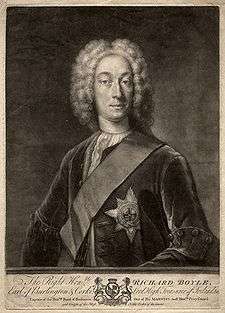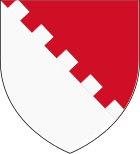Earl of Cork

and 4th Earl of Cork
Earl of the County of Cork, usually shortened to Earl of Cork, is a title in the Peerage of Ireland. It was created in 1620 for the Anglo-Irish politician Richard Boyle, 1st Baron Boyle. He had already been created Lord Boyle, Baron of Youghal, in the County of Cork, in 1616, and was made Viscount of Dungarvan, in the County of Waterford, at the same time he was given the earldom. These titles are also in the Peerage of Ireland. Known as the "Great Earl", he was born in Canterbury, England, but settled in Ireland in 1588, where he married an Irish heiress and bought large estates in County Cork. From 1631 to 1643 he served as Lord Treasurer of Ireland. His third son the Hon. Sir Roger Boyle was created Earl of Orrery in 1660. The first Earl of Cork was remarkable for having four of his sons created peers; his remaining son was Robert Boyle, the physicist, discoverer of Boyle's Law, whose fame may outlast all his brothers' together.
Lord Cork was succeeded by his second son, another Richard Boyle, the second Earl; his eldest son died young. This Richard Boyle had already succeeded his younger brother as second Viscount Boyle of Kinalmeaky according to a special remainder in the letters patent. He married Elizabeth Clifford, 2nd Baroness Clifford, and in 1644 he was created Baron Clifford of Lanesborough, in the County of York, in the Peerage of England. Lord Cork later served as Lord High Treasurer of Ireland and as Lord Lieutenant of the West Riding of Yorkshire. In 1664 he was further honoured when he was made Earl of Burlington in the Peerage of England. His only son and heir apparent Charles Boyle, Viscount Dungarvan, was summoned to the Irish House of Lords through a writ of acceleration in his father's junior title of Viscount Dungarvan in 1663. He later represented Tamworth and Yorkshire in the English House of Commons. In 1689 he was summoned to the English House of Lords through a writ of acceleration in his father's junior title of Baron Clifford of Lanesborough.

Lord Cork was succeeded by his grandson, the third Earl, the son of Viscount Dungarvan. He was Lord Treasurer of Ireland and Lord Lieutenant of the West Riding of Yorkshire. On his death the titles passed to his only son, the fourth Earl of Cork and third Earl of Burlington. Known as Lord Burlington, he was the famous architect who published Andrea Palladio's designs of Ancient Roman architecture and designed Chiswick House with William Kent. He had no sons and on his death in 1753 the barony of Clifford of Lanesborough and earldom of Burlington became extinct. He was succeeded in the Burlington estates and in the barony of Clifford by his eldest surviving daughter Charlotte Elizabeth Boyle, 6th Baroness Clifford (see the Baron Clifford for later history of this title). She married William Cavendish, 4th Duke of Devonshire. Their third son Lord George Augustus Henry Cavendish was created Earl of Burlington in 1831.
Lord Burlington was succeeded in the earldom of Cork and the other remaining titles by his third cousin John Boyle, 5th Earl of Orrery, who became the fifth Earl of Cork as well (he was descended from the third son of the first Earl of Cork, and had also inherited the titles of Baron Broghill [Ireland] and Baron Boyle of Marston in the Peerage of Great Britain, thus a seat in the British House of Lords until 1999 (see the Earl of Orrery for earlier history of this branch of the family). He was a writer and a friend of Jonathan Swift, Alexander Pope and Samuel Johnson. He was succeeded by his second but eldest surviving son, the sixth Earl. He represented Charleville in the Irish House of Commons and Warwick in the British House of Commons. He died unmarried at the age of thirty-three and was succeeded by his half-brother, Edmund Boyle, 7th Earl of Cork. The seventh Earl is remembered only for the fame of his second wife Mary Boyle, Countess of Cork and Orrery, the celebrated Lady Cork whose salon was a centre of intellectual life for fifty years. On his death in 1798 the titles passed to his second but eldest surviving son, the eighth Earl. He was a General in the Army and fought in the Revolutionary and Napoleonic Wars.

He was succeeded by his grandson, the ninth Earl. He was the son of Captain Charles Boyle, Viscount Dungarvan. Lord Cork was a Liberal politician and served as Master of the Buckhounds and as Master of the Horse under Lord Russell, William Ewart Gladstone and Lord Rosebery. His eldest son, the tenth Earl, fought in the Second Boer War but died childless in 1925. He was succeeded by his younger brother, the eleventh Earl. He also died childless and was succeeded by his second cousin, the twelfth Earl. He was the grandson of the Hon. John Boyle, third son of the eighth Earl. Lord Cork was an Admiral of the Fleet and notably commanded the combined expedition for the capture of Narvik in 1940. He was childless and was succeeded by his nephew, the thirteenth Earl. He was the eldest son of Major the Hon. Reginald Courtenay Boyle. He served as a Deputy Speaker of the House of Lords and as Deputy Chairman of Committees in the House of Lords from 1973 to 1978. He died childless and was succeeded by his younger brother, the fourteenth Earl. As of 2016 the titles are held by the latter's eldest son, the fifteenth Earl, who succeeded in 2003.
Earl of Cork (1394?)
Edward of Norwich, Earl of Rutland, the first son of Edmund of Langley, 1st Duke of York, fifth son of Edward III of England, favorite of his cousin Richard II, had been created Earl of Cork in the Peerage of Ireland during his nephew's personal reign. While the creation is unrecorded, he campaigned in Ireland from 1394 to 1395, and both he and King Richard use the title in letters that spring.
He is usually called by some other of his many titles; Rutland, Aumale, or York. He was created Duke of Aumale in 1397, and deprived of the dukedom 6 October 1399, as a consequence of the deposition of Richard II; he succeeded his father as Duke of York in 1402. This Earldom, and all honours created for him, became extinct when he died childless at the battle of Agincourt in 1415.
Coat of arms
Per bend embattled gules and argent. The motto is God's providence is my inheritance.[1]
Earls of Cork (1620)
- Heirs who did not live to succeed to the Earldom are indented.
- Richard Boyle, 1st Earl of Cork (1566–1643)
- Roger Boyle (1606–1615)
- Richard Boyle, 1st Earl of Burlington and 2nd Earl of Cork (1612–1698)
- Charles Boyle, 3rd Viscount Dungarvan (1639–1694)
- Charles Boyle, 2nd Earl of Burlington and 3rd Earl of Cork (bef. 1674–1703)
- Richard Boyle, 3rd Earl of Burlington and 4th Earl of Cork (1694–1753)
- John Boyle, 5th Earl of Cork and 5th Earl of Orrery (1707–1762)
- Charles Boyle, Viscount Dungarvan (1729–1759)
- Hamilton Boyle, 6th Earl of Cork and 6th Earl of Orrery (1729–1764)
- Edmund Boyle, 7th Earl of Cork and 7th Earl of Orrery (1742–1798)
- John Richard Boyle, Viscount Dungarvan (1765–1768)
- Edmund Boyle, 8th Earl of Cork and 8th Earl of Orrery (1767–1856)
- Edmund William Boyle, Viscount Dungarvan (1798–1826)
- Charles Boyle, Viscount Dungarvan (1800–1834)
- Richard Edmund St Lawrence Boyle, 9th Earl of Cork and 9th Earl of Orrery (1829–1904)
- Charles Spencer Canning Boyle, 10th Earl of Cork and 10th Earl of Orrery (1861–1925)
- Robert John Lascelles Boyle, 11th Earl of Cork and 11th Earl of Orrery (1864–1934)
- William Henry Dudley Boyle, 12th Earl of Cork and 12th Earl of Orrery (1873–1967)
- Patrick Reginald Boyle, 13th Earl of Cork and 13th Earl of Orrery (1910–1995)
- John William Boyle, 14th Earl of Cork and 14th Earl of Orrery (1916–2003)
- John Richard Boyle, 15th Earl of Cork and 15th Earl of Orrery (born 1945)
The heir apparent is the present holder's son Hon (Rory) Jonathan Courtenay Boyle, Viscount Dungarvan (born 1978)
See also
- Viscount Boyle of Kinalmeaky
- Earl of Orrery
- Earl of Shannon
- Viscount Shannon
- Baron Carleton (1714 creation)
- Earl of Burlington
- Viscount Blesington
- Viscount Dungarvan
Notes
- ↑ Townend, Peter (ed.). Burke's Genealogical and Heraldic History of the Peerage, Baronetage and Knightage (103rd Edition). Burke's Peerage Limited. p. 585.
References
- Kidd, Charles, Williamson, David (editors). Debrett's Peerage and Baronetage (1990 edition). New York: St Martin's Press, 1990,
- Leigh Rayment's Peerage Pages
External links
- Hansard 1803–2005: contributions in Parliament by Robert John Lascelles Boyle, 11th Earl of Cork
- Hansard 1803–2005: contributions in Parliament by Patrick Reginald Boyle, 13th Earl of Cork